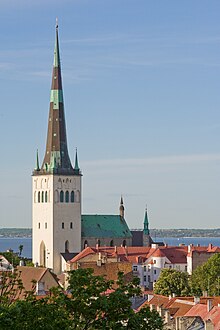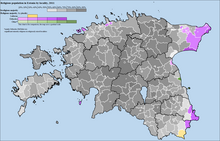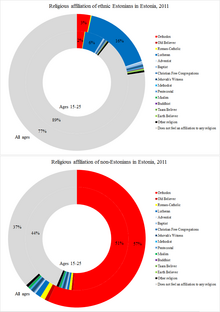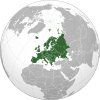愛沙尼亞宗教

愛沙尼亞歷史上和傳統上是一個基督新教路德宗國家[3][4][5],然而,愛沙尼亞是世界上「宗教信仰比例低」的國家之一,只有14%的人宣稱宗教是其他們的日常生活重要組成部分。 [6]
愛沙尼亞宗教人口主要是基督徒,宗派大都屬於路德宗和正教會。[7]在蘇聯的無神論政策下,「大多數家庭的宗教傳統鏈條被打破」。[4][8]第二次世界大戰前,愛沙尼亞約有80%的新教基督徒 ;屬於路德宗。
在2001年至2011年的人口普查中,正教會信仰人數超越了路德宗,成為該國最大的基督宗教教派。然而,路德宗仍然是愛沙尼亞人中最受歡迎的宗教教派(11%是路德教派),正教會主要由的斯拉夫族裔(約佔45%)所信奉。根據塔爾圖大學指出,不信教的愛沙尼亞人不一定是無神論者,新異教主義、佛教徒和印度教徒宣稱自己是「不信教」的人。[9]
歷史
[編輯]

公元十三世紀,條頓騎士團把基督宗教傳進了愛沙尼亞,在宗教改革前,愛沙尼亞地區主要教會為天主教。在宗教改革期間,愛沙尼亞福音路德教會變成主要教會。[10] 在第二次世界大戰之前,愛沙尼亞約有80%是新教基督徒,絕大多數屬於路德教派,也有歸正宗及其他新教教派。Robert T. Francoeur和Raymond J. Noonan寫道:「1925年,教會與國家分離,但宗教教育仍在學校教授,牧師在塔爾圖大學神學院受訓。隨著蘇聯的佔領和蘇聯反宗教立法的執行,基督新教教會失去了三分之二以上的神職人員,教會財產被國有化,神學院被關閉。愛沙尼亞許多教堂1941年至1944年在德國佔領愛沙尼亞時被摧毀。蘇聯解體後,反宗教的法律被廢除。[11]
人口統計
[編輯]不到三分之一的愛沙尼亞人有宗教信仰; 其中大部分是正教會(主要是斯拉夫族裔)或路德宗教派。還有一些少數其他宗教教派:穆斯林,猶太教和佛教。
人口統計
[編輯]| 宗教教派 | 2000[12] | 2011[1] | ||
|---|---|---|---|---|
| 人數 | % | 人數 | % | |
| 正教會 | 143,554 | 12.80 | 176,773 | 16.15 |
| 路德宗 | 152,237 | 13.57 | 108,513 | 9.91 |
| 浸信宗 | 6,009 | 0.54 | 4,507 | 0.41 |
| 天主教 | 5,745 | 0.51 | 4,501 | 0.41 |
| 耶和華見證人 | 3,823 | 0.34 | 3,938 | 0.36 |
| 舊禮儀派 | 2,515 | 0.22 | 2,605 | 0.24 |
| 公理會 | 223 | 0.02 | 2,189 | 0.20 |
| 愛沙尼亞本土原始信仰(Maausk) | 1,058 | 0.09 | 1,925 | 0.18 |
| 愛沙尼亞本土原始信仰(Taara faith) | 1,047 | 0.10 | ||
| 五旬節運動 | 2,648 | 0.24 | 1,855 | 0.17 |
| 穆斯林 | 1,387 | 0.12 | 1,508 | 0.14 |
| 基督復臨安息日會 | 1,561 | 0.14 | 1,194 | 0.11 |
| 佛教 | 622 | 0.06 | 1,145 | 0.10 |
| 衛理宗 | 1,455 | 0.13 | 1,098 | 0.10 |
| 其他宗教 | 4,995 | 0.45 | 8,074 | 0.74 |
| 無宗教 | 450,458 | 40.16 | 592,588 | 54.14 |
| 未表態 | 343,292 | 30.61 | 181,104 | 16.55 |
| 全部1 | 1,121,582 | 100.00 | 1,094,564 | 99.00 |
1Population, persons aged 15 and older.
各種族宗教
[編輯]| 種族 | 總人口數[13] | 正教會 | 路德宗 | 浸信宗 | 天主教 | 耶和華見證人 | 舊禮儀派 | 五旬節運動 | 穆斯林 | 佛教 | 愛沙尼亞本土原始信仰 | 其他基督徒 | 其他宗教 | 無宗教或未表態 | |||||||||||||
|---|---|---|---|---|---|---|---|---|---|---|---|---|---|---|---|---|---|---|---|---|---|---|---|---|---|---|---|
| N | % | N | % | N | % | N | % | N | % | N | % | N | % | N | % | N | % | N | % | N | % | N | % | N | % | ||
| 愛沙尼亞族 | 902,547 | 20,585 | 2.28 | 104,691 | 11.5 | 3,648 | 0.4 | 1,314 | 0.14 | 1,982 | 0.2 | 194 | 0.02 | 1,086 | 0.1 | 148 | 0.0 | 978 | 0.1 | 2,941 | 0.3 | 4,439 | 0.49 | 2,759 | 0.3 | 605,822 | 67.12 |
| 俄羅斯族 | 326,235 | 142,971 | 43.8 | 862 | 0.26 | 515 | 0.15 | 560 | 0.17 | 1,322 | 0.4 | 2,368 | 0.72 | 512 | 0.15 | 107 | 0.03 | 114 | 0.03 | — | 1,344 | 0.41 | 687 | 0.21 | 140,223 | 42.9 | |
| 烏克蘭族 | 22,573 | 10,816 | 47.9 | 99 | 0.43 | 155 | 0.68 | 121 | 0.53 | 330 | 1.46 | — | 147 | 0.65 | — | — | — | 252 | 1.1 | 159 | 0.7 | 9,416 | 41.7 | ||||
| 保加利亞人 | 12,579 | 6,188 | 49.1 | 44 | 0.34 | 44 | 0.34 | 598 | 4.7 | 55 | 0.43 | — | 22 | 0.17 | — | — | — | 55 | 0.43 | 45 | 0.35 | 5,188 | 41.2 | ||||
| 芬蘭人 | 7,589 | 818 | 10.7 | 1,948 | 25.6 | 36 | 0.47 | 33 | 0.43 | 108 | 1.4 | 7 | 0.1 | 21 | 0.27 | — | 9 | 0.11 | 8 | 0.1 | 45 | 0.59 | 29 | 0.38 | 4,131 | 54.4 | |
| 塔塔爾族 | 1,993 | 174 | 8.7 | 5 | 0.25 | 4 | 0.2 | — | 5 | 0.25 | — | 7 | 0.35 | 604 | 30.3 | — | — | 8 | 0.4 | 8 | 0.4 | 1,067 | 53.5 | ||||
| 拉脫維亞人 | 1,764 | 254 | 14.3 | 221 | 12.5 | 9 | 0.5 | 140 | 7.9 | 7 | 0.39 | 3 | 0.17 | 6 | 0.34 | — | — | — | 13 | 0.73 | 8 | 0.45 | 954 | 54 | |||
| 德裔 | 1,544 | 274 | 17.7 | 203 | 13.1 | 26 | 1.68 | 78 | 5 | 14 | 0.9 | — | 6 | 0.38 | — | — | — | 31 | 2 | 15 | 0.97 | 734 | 47.4 | ||||
調查
[編輯]- 蓋洛普 2006-2008年的一項調查顯示,14%的愛沙尼亞人表示「宗教是你日常生活的重要組成部分」這個問題是積極的,這在所有調查的143個國家中是最低的。[14]
- 2015年皮尤研究中心的一項調查發現,愛沙尼亞人口中有51%宣稱是基督徒,45%是無宗教的(這個類別包括無神論者,不可知論者和表態「沒有一定信仰」的人),而2%屬於其他信仰。[15]基督徒中東正教25%,路德宗20%,其他基督徒的5%和天主教1%。[16]非宗教人士有9%無神論者,1%不可知論者和35%「沒有什麼特定信仰」。[17]
- 國際社會調查計畫2015年調查發現,愛沙尼亞人口有57.0%宣布屬於一個基督宗教教派(東正教27.6%,路德宗26.0%,其他基督宗派3.3%),只有38.9%的人宣稱沒有宗教信仰。[18]
參見
[編輯]參考注釋
[編輯]- ^ 1.0 1.1 1.2 PC0454: AT LEAST 15-YEAR-OLD PERSONS BY RELIGION, SEX, AGE GROUP, ETHNIC NATIONALITY AND COUNTY, 31 DECEMBER 2011. Statistics Estonia. 2011-12-31 [2014-01-09]. (原始內容存檔於2017-10-14).
- ^ PHC 2011: over a quarter of the population are affiliated with a particular religion. Statistics Estonia. 2013-04-29 [2014-01-09]. (原始內容存檔於2017-11-24).
- ^ Ivković, Sanja Kutnjak; Haberfeld, M.R. Measuring Police Integrity Across the World: Studies from Established Democracies and Countries in Transition. Springer. 2015-06-10: 131. ISBN 9781493922796 (英語).
Estonia is considered Protestant when classified by its historically predominant major religion (Norris and Inglehart 2011) and thus some authors (e.g., Davie 2003) claim Estonia belongs to Western (Lutheran) Europe, while others (e.g., Norris and Inglehart 2011) see Estonia as a Protestant ex-Communist society.
- ^ 4.0 4.1 引用錯誤:沒有為名為
MarshallCavendish2010的參考文獻提供內容 - ^ Rausing, Sigrid. History, Memory, and Identity in Post-Soviet Estonia: The End of a Collective Farm. Oxford University Press. 2004: 96. ISBN 9780199263189 (英語).
Protestantism has done much to inform the moral world view of the Estonians, particularly the process of distinguishing themselves from the Russians.
- ^ Estonians least religious in the world. EU Observer. 2009-02-11 [2014-01-09]. (原始內容存檔於2016-07-05).
- ^ Eestis on 90 usuvoolu: lilla leegi hoidjad, kopimistid, tulekummardajad... [Estonia has 90 religious affiliations: Keepers of the violet flame, Kopimists, Fire worshipers]. Postimees. 2013-04-29 [2014-01-09]. (原始內容存檔於2017-07-26).
- ^ Ringvee, Ringo. Is Estonia really the least religious country in the world?. The Guardian. 2011-09-16.
For this situation there are several reasons, starting from the distant past (the close connection of the churches with the Swedish or German ruling classes) up to the Soviet-period atheist policy when the chain of religious traditions was broken in most families. In Estonia, religion has never played an important role on the political or ideological battlefield. The institutional religious life was dominated by foreigners until the early 20th century. The tendencies that prevailed in the late 1930s for closer relations between the state and Lutheran church [...] ended with the Soviet occupation in 1940.
- ^ Martin Noorkõiv (6 November 2012). "The Estonian Atheist Experiment" (頁面存檔備份,存於網際網路檔案館). University of Tartu Blog.
- ^ Francoeur, Robert T.; Noonan, Raymond J. The Continuum Complete International Encyclopedia of Sexuality. A&C Black. 2004: 361. ISBN 9780826414885.
The dominant religion in Estonia is Evangelical Lutheranism. Estonians were Christianized by the Teutonic Knights in the 13th century. During the Reformation, Lutheranism spread, and the church was officially established in Estonia in 1686.
- ^ Francoeur, Robert T.; Noonan, Raymond J. The Continuum Complete International Encyclopedia of Sexuality. A&C Black. 2004: 361. ISBN 9780826414885.
It was not until 1998 that the state's religious policies became tolerant, and by 1990, repressive legislation was annulled.
- ^ PC231: POPULATION BY RELIGIOUS AFFILIATION AND ETHNIC NATIONALITY. Statistics Estonia. 2000-03-31 [2014-01-09]. (原始內容存檔於2018-07-19).
- ^ PC0428: POPULATION BY ETHNIC NATIONALITY, SEX AND PLACE OF RESIDENCE, 31 DECEMBER 2011. [2020-09-13]. (原始內容存檔於2017-10-18).
- ^ Crabtree, Steve; Pelham, Brett. What Alabamians and Iranians Have in Common. Gallup. 2009-02-09 [2010-02-21]. (原始內容存檔於2017-07-23).
- ^ ANALYSIS. Religious Belief and National Belonging in Central and Eastern Europe (PDF). 2017-05-10 [2017-05-12]. (原始內容 (PDF)存檔於2017年5月13日).
- ^ Religious Belief and National Belonging in Central and Eastern Europe: National and religious identities converge in a region once dominated by atheist regimes. [2018-02-09]. (原始內容存檔於2017-05-10).
- ^ Religious Belief and National Belonging in Central and Eastern Europe: 1. Religious affiliation (頁面存檔備份,存於網際網路檔案館); Pew Research Center, 10 May 2017
- ^ Country specific religious affiliation or denomination: Estonia - weighted. International Social Survey Programme: Work Orientations IV - ISSP 2015. 2015 [2018-02-09]. (原始內容存檔於2019-12-12) –透過GESIS.

